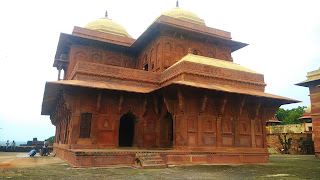Fatehpur Sikri: A Maze of Mughal Monuments

Panch Mahal, Fatehpur Sikri About 39 km from the touristy site of Agra, Fatehpur Sikri is considered as an architectural marvel of medieval India. Today the ghost town of Fatehpur Sikri astonishes visitors and history buffs with its majesty and scope. Declared a UNESCO World Heritage Site in 1986, the city-palace complex of Fatehpur Sikri is home to tombs, royal palaces and courts. Built by the greatest Mughal emperor Akbar, Fatehpur Sikri was the seat of his government from 1571 to 1585. The English traveler Ralph Fitch , who has left an eyewitness account of the social life and economic condition of the Mughal India, visited the Mughal court of Akbar at Fatehpur Sikri in 1585 and wrote, 'Agra and Fatepore are two very great cities, either of them much greater than London and very populous.’ However, the capital was abandoned in 1585 by Akbar. Scarcity of water is the popular explanation for this abandonment. The Mughal emperor made Lahore his new capital, which remained so til




